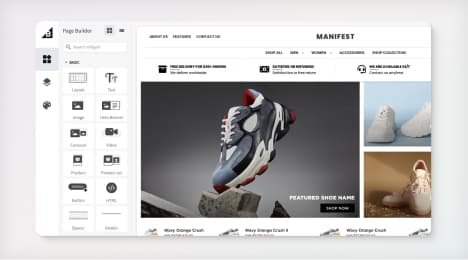
Watch Our Product Tour
See how BigCommerce helps you build and manage your online store with ease.
- Ecommerce Insights

6 Key Steps to Launch Your Online Store
Explore our Launch Foundations series to get your BigCommerce store up and running quickly.
BigCommerce helps growing businesses, enterprise brands, and everything in-between sell more online.
How to write product descriptions that tell a story
Compelling product descriptions don't just convey what your product is, but why a customer should buy it. Online shoppers want to know what a product means for them before purchasing, which is why descriptions are often the difference between a customer clicking "add to cart" and looking elsewhere. A well-written product description illustrates a product's features by way of its benefits, telling a story of how that product will impact customers' lives. Though it might sound like a tall order, storytelling with your product descriptions isn't as complicated as it sounds. Use the following checklist to begin crafting descriptions that truly speak to customers; before too long, you'll perfect the formula and increase your conversion rate in the process.
1. Think about the customer, not the product
It's often our first instinct to think first and foremost about the product when telling its story, but an effective description is really catered to the customer. To make sure you're taking a customer-centric view of everything from what you include to how you describe it, imagine yourtarget customer in as much detail as possible. Do they like a serious tone or one that's more fun and playful? What questions might be top of mind for them about this product?
Speak directly to this audience as you write, as if you were talking to them face-to-face in a brick-and-mortar store. Use words they would use, talk about features they would care most about and don't be afraid to write with personality. By talking like them—and to them—you'll connect with your target customer and will be one step closer to a sale.
2. Set a scene
Yes, a teapot boils water and a mug holds liquid. But don't stop there. If you run a home-goods ecommerce store, talk about how the teapot or mug will make your customer's morning routine easier and more enjoyable. Instead of rattling off a list of technical specifications, relay them through their day-to-day impact. If your description paints a picture in the customer's mind, they're much more likely to consider it a must-have.
3. Anticipate customer questions
In a brick-and-mortar store, it's easy for a customer to read product specs from the box, or ask a salesperson if they have questions. If someone is confused at your ecommerce store, the easiest option is to look elsewhere online.
To prevent that, try to anticipate customer questions and provide as many details as possible. What are the dimensions and weight of the product? What materials is it made with and what are the care instructions? Where was the product made? What does the product come with? Is there a warranty or certificate of authentication? Beyond the product, communicate any store policies (such as returns) or feedback mechanisms (is it a top seller with great reviews?). Those details can reduce customer worries about the product's quality and help the customer feel your shop is helpful and transparent with information.
4. Make your descriptions user-friendly
Some customers will want to sink their teeth into a paragraph-long description and read an enticing story in order to imagine using this product in real life. Others will scan a description looking for keywords. Trying to satisfy both types of customers in one paragraph can create disjointed descriptions, so instead consider including a bulleted list. The list of key features and claims to fame can still include descriptive, evocative language, but keep it short. Each bullet point should be no more than eight words, and these don't have to be structured as full sentences.
Some shoppers read product descriptions with a fine-toothed comb.
5. Show, don't tell
It's one of the first lessons every writer learns: fluffy superlatives aren't nearly as powerful as concrete descriptions. Don't say a handbag is "high-quality" - instead, describe the factors that make it great. Once you've written your product description, scrutinize it for any filler words and replace them with details instead. Is the "high-quality" handbag made by hand with Italian leather? Can it withstand years of rugged wear? Is it sewn with hand-dyed materials? Specific descriptions make your story come to life—and help your product stand out.
6. Proofread
Though it's easy to overlook, typos and grammar errors can take a product page from enticing to unprofessional. Read everything over—twice—and then ask someone else on your team to give it a read. Remember that online norms still apply to ecommerce: using all-caps reads like shouting, and using too many symbols can look cluttered. Put the same time and attention into your product descriptions as you do for the products themselves, and customers will take notice.
BigCommerce helps growing businesses, enterprise brands, and everything in-between sell more online.
Start growing your ecommerce business even faster.
High-volume or established business? Request a demo